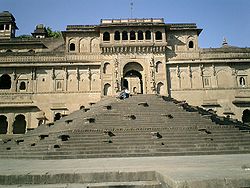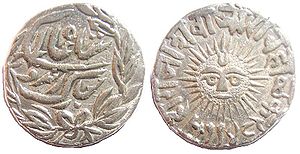- Holkar
-
Holkar Maharaja of Indore Former Monarchy 
Flag of Indore State 
The Rajwada, royal palace of the Holkar dynasty, Indore First monarch Malhar Rao Holkar I Last monarch Yeshwantrao Holkar II Official residence Rajwada, Indaur Monarchy started 1731 Monarchy ended 1948 The Holkar dynasty (Marathi: होळकर घराणे), whose earliest known clan-man was Malhar Rao, who joined the service of the Peshwa in 1721, and quickly rose to the ranks of Subedar. He and his descendants ruled as Rajas and later Maharajas of Indaur (better known as Indore) in Central India as an independent member of the Maratha Confederacy until 1818, and afterwards as a princely state -under protectorate- of British India with a 19-guns salute (21 guns locally; a rare high rank) until India's independence, when the state acceded to the Indian government.
They are one of the prestigious dynasties whose name became associated with the very title of the ruler, which was generally known as Maharaja Holkar or Holkar Maharaja, while the official full title was Maharajadhiraj Raj Rajeshwar Sawai Shri (personal name) Holkar Bahadur, Maharaja of Indore, with the colonial style of His Highness.
Contents
Establishment of the Holkar rule
 Fort Ahilya in Maheshwar
Fort Ahilya in Maheshwar
Malharrao Holkar (born 1694, died 1766) established the family's rule over Indore. He commanded Maratha armies in Malwa region in the 1720s, and in 1733 was granted 9 parghanas in the vicinity of Indore by the Peshwa. The township of Indore had already existed as an independent principality established by Nandlal Mandloi of Kampel, sanctioned by the Mughal Imperial order, dated March 3, 1716. It was Nandlal Mandloi who granted the Marathas access through the region and allowed them to camp across the Khan(Kanh:Original Name) River. Malhar Rao established a camp, later called Malharganj, only in 1734. In 1747, he started the construction of his royal palace, the Rajwada. By the time of his death, he ruled much of Malwa, and was acknowledged as one of the five virtually independent rulers of the Maratha Confederacy.
He was succeeded by Ahilyabai Holkar (reigned 1767–1795), his daughter-in-law. She was born in the village 'Chaundi' in Maharashtra. She moved the capital to Maheshwar, south of Indore on the Narmada River. Rani Ahilyabai was a great builder and patron of many Hindu temples, who embellished Maheshwar and Indore. She also built temples at sacred sites outside her kingdom, from Dwarka in Gujarat east to the Kashi Vishwanath Temple at Varanasi on the Ganges.
The adopted son of Malhar Rao Haolkar, Tukojirao Holkar (ruled 1795-1797) briefly succeeded Rani Ahilyabai upon her death. Although Tukoji Rao, as Ahilyabai's commander started operating from Indore in March 1767 - half-a-century after its establishment by the senior Mandloi. And, Holkars did not settle in Indore until 1818 - a century after the Indore settlement was formally established by the Mandlois.
Yashwantrao Holkar- extending the Holkar dominion
His son Yashwantrao Holkar (reigned 1797–1811) (also called as Jaswant Rao) succeeded him upon his death. He decided to free the Delhi Mughal Emperor Shah Alam from the British but was unsuccessful. Admiring his bravery, Shah Alam gave him the title of "Maharajadiraj Rajrajeshwar Alija Bahadur".
Yashwantrao Holkar defeated the combined armies of Scindia and Peshwa Bajirao II at Hadapsar, near Pune in 1802. The Peshwa fled from Pune, scared of being killed by Yashwantrao Holkar - owing to his (Bajirao's) killing Vitthojirao Holkar a few years earlier. Bajirao quit Pune and fled to Bassein where the English offered him allurements to sign the Subsidiary Treaty in return for the throne. Meanwhile, Yashwantrao made Amrutrao as the next Peshwa in Pune. After deliberating for over a month and after threats that his brother would otherwise be recognised as Peshwa, Bajirao II signed the treaty surrendering his residual sovereignty and allowing the English to put him on the throne at Poona.
Maharaja Yashwantrao Holkar saw that rest of the Kings were not ready to unite and were interested in personal benefits, he was the last to sign a treaty with the British on 24 December, 1805 at a place called Rajghat (Treaty of Rajghat). He was the only King in India to whom the British approached to sign a peace treaty. He didn’t accept any condition which would affect his self respect. The British recognised him as a sovereign King and returned all his territories. They accepted his dominion over Jaipur, Udaipur, Kota, Bundi, and some Rajput Kings. They also accepted that they would not interfere in the matters of Holkars. Yashwantrao Holkar was a gifted military leader, and battled the British in the Second Anglo-Maratha War. After some early victories, he made peace with the British.
Battle of Mahidpur
In 1811, Maharaja Malharrao Holkar III succeeded Maharaja Yashwantrao Holkar at an age of 4 years. Maharani Tulsabai Holkar looked after the administration. However, Dharama Kunwar and Balaram Seth with the help of Pathans and Pindaris, who had secretly joined hands with the British, plotted to imprison Tulsabai and Malharrao[citation needed]. When Tulsabai learnt about this, she beheaded both of them in 1815 and appointed Tantia Jog. Due to this, Gaffur Khan Pindari secretly signed a treaty with the British on 9 November 1817 and accordingly killed Tulsabai on 19 December 1817.
The British, led by Sir Thomas Hislop, attacked on 20 December 1817 and defeated the army led by 11 year old Maharaja Malharrao Holhar III, 20 year old Harirao Holkar and 20 year old Bhimabai Holkar in the Battle of Mahidpur. Holkars had nearly won the war but at the deciding moment Nawab Abdul Gaffur Khan betrayed and left the battlefield along with his army. The British gave the Jahagir of Jawara to Gaffur Khan for this betrayal. The treaty was signed on 6 January 1818 at Mandsaur. Bhimabai Holkar didn't accept the treaty, and kept attacking the British by guerilla methods. Maharani Laxmibai of Jhanshi took inspiration from Bhimabai Holkar and fought against the British. At the conclusion of this Third Anglo-Maratha War, the Holkars lost much of their territory to the British and were incorporated into the British Raj as a princely state of the Central India Agency. The capital was shifted from Bhanpura to Indore.
Princely State
 A silver rupee of Shivajirao Holkar 1886-1903, minted at Indore in Vikram Samvat 1948 (1891)
A silver rupee of Shivajirao Holkar 1886-1903, minted at Indore in Vikram Samvat 1948 (1891)
Malharrao Holkar III entered Indore on 2 Novemember 1818. Tantia Jog was appointed his Diwan as he was a minor. As the old palace was destroyed by the army of Daulat Rao Scindia, a new palace was constructed in its place. Malharrao III was succeeded by Martandrao, who formally ascended to the throne on 17 January 1834. But he was replaced by Harirao Holkar, nephew of Yashwantrao, who ascended to the throne on 17 April 1834. He adopted Khanderao Holkar on 2 July 1841 and died on 24 october 1843. Khanderao was formally installed as the ruler on 13 November 1843, but he suddenly died on 17 February 1844. Tukojirao Holkar II (1835-1886) was installed on the throne on 27 June 1844. During the Indian Rebellion of 1857, he was loyal to the British East India Company. In October 1872, he appointed T. Madhava Rao as the Diwan of Indore. He died on 17 June 1886 and succeeded by his eldest son, Shivajirao.
Yashwantrao II (reigned 1926–1948) ruled Indore state until shortly after India's independence in 1947, when he acceded to the Indian Government. Indore became a district of Madhya Bharat state, which was merged into Madhya Pradesh state in 1956.
Descendants
- Richard Holkar.
- Sabrina Holkar married to Jewish-Indian real estate developer Ari Ellis. They live in Union Square in Manhattan.
- Yeshwant Rao Holkar
- Usha Devi Maharaj Sahiba Holkar XV Bahadur.
- Ranjit Malhotra
- Dilip Malhotra
- Vijayendra Ghatge, grandson of Maharaja Tukoji Rao Holkar [1] through his daughter Sita Raje Ghatge is a Bollywood Actor. (Kagal Junior vassal state)
- Sagarika Ghatge, daughter of Vijayendra Ghatge is a Bollywood actress.
Holkar Maharajas of Indore
- Malhar Rao Holkar I (reigned 2 November 1731 - 19 May 1766)
- Malerao Holkar (reigned 23 August 1766 - 5 April 1767)
- Ahilyabai Holkar (first as a regent on May 26, 1766) (reigned 27 March 1767 - 13 August 1795)
- Tukojirao Holkar I (reigned 13 August 1795 - 29 January 1797)
- Kashirao Holkar (reigned 29 January 1797 - 1798)
- Yeshwantrao Holkar I (reigned 1798 - 27 October 1811)
- Malharrao Holkar III (reigned 27 October 1811 - 27 October 1833)
- Martandrao Holkar (reigned 17 January 1834 - 2 February 1834)
- Harirao Holkar (reigned 17 April 1834 - 24 October 1843)
- Khanderao Holkar III (reigned 13 November 1843 - 17 February 1844)
- Tukojirao Holkar II (reigned 27 June 1844 - 17 June 1886)
- Shivajirao Holkar (reigned 17 June 1886 - 31 January 1903)
- Tukojirao Holkar III (reigned 31 January 1903 - 26 February 1926)
- Yeshwantrao Holkar II (reigned 26 February 1926 - 1948)
(On 22nd April 1948 the Maharaja of Indore signed a covenant with the rulers of the adjoining princely states to form a new state known as Madhya Bharat. Madhya Bharat was created on 28 May, 1948. The Princely State of Indore was merged with the Union of India on 16th June 1948)
See also
Notes
References
- Sethi, P.K., S.K. Bhatt and R. Holkar (1976). A Study of Holkar State Coinage, Indore: The Academy of Indian Numismatics and Sigillography.
- Somerset Playne (compiler), R. V. Solomon, J. W. Bond, Arnold Wright (1922). Indian States: A Biographical, Historical, and Administrative Survey, London: Foreign and Colonial Compiling and Publishing Co., 1922 (also Asian Educational Services, 2006, ISBN 812061965X, 9788120619654, 835 pages
External links
Maratha Empire Rulers Peshwas Moropant Pingle · Ramchandra Pant Amatya · Bahiroji Pingale · Parshuram Tribak Kulkarni · Balaji Vishwanath · Bajirao · Balaji Bajirao · Madhavrao Ballal · Narayanrao · Raghunathrao · Sawai Madhavrao · Baji Rao II · Amrutrao · Nana SahibMaratha Confederacy (Subsidiary or Feudatory states) Battles Pratapgarh · Kolhapur · Pavan Khind · Surat · Sinhagad · Palkhed · Mandsaur · 1st Delhi · Vasai · Trichinopoly · Expeditions in Bengal · 3rd Panipat · Rakshabhuvan · Panchgaon · Gajendragad · Lalsot · Patan · Kharda · Poona · 2nd Delhi · Assaye · Laswari · Farrukhabad · Bharatpur · Khadki · Koregaon · Mahidpur · Maratha-Mysore War · full list ·Wars Adversaries Adilshahi · Mughal Empire · Durrani Empire · British Empire · Portuguese Empire · Hyderabad · Sultanate of MysoreForts Categories:- Dynasties of India
- Maratha Empire
- History of Malwa
- Indore
- Richard Holkar.
Wikimedia Foundation. 2010.
